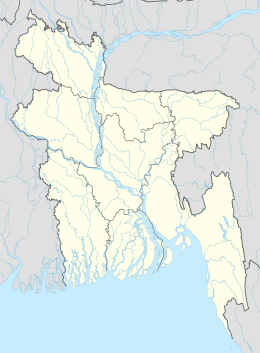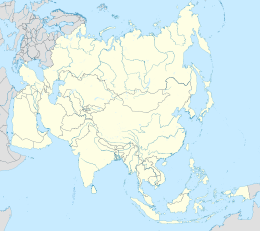Firingi Bazar: Difference between revisions
The creation of Firingi Bazar Tags: possible cut and paste move or recreation Visual edit Mobile edit Mobile web edit Disambiguation links added |
m Minor changes regarding unnecessary info. Tags: Visual edit Mobile edit Mobile web edit |
||
| Line 106: | Line 106: | ||
One of the world's oldest ports with a functional [[natural harbour|natural harbor]] for centuries,<ref name="auto1">{{Cite book|last1=Ring|first1=Trudy|url=https://books.google.com/books?id=voerPYsAB5wC&q=chittagong+ptolemy&pg=PA186|title=Asia and Oceania: International Dictionary of Historic Places|last2=Watson|first2=Noelle|last3=Schellinger|first3=Paul|date=12 November 2012|publisher=Routledge|isbn=978-1-136-63979-1|language=en}}</ref> Chittagong appeared on ancient [[ancient Greece|Greek]] and [[ancient Rome|Roman]] maps, including on [[Ptolemy's world map]]. It was located on the southern branch of the [[Silk Road]]. In the 9th century, merchants from the [[Abbasid Caliphate]] established a trading post in Chittagong.<ref name="bp-arabs" /><ref>{{cite journal |last1=Islam |first1=Shariful |last2=Hoque |first2=Muhammad Manirul |date= |title=Unpublished Umayyad and Abbasid Silver Coins in the Bangladesh National Museum |url=https://www.asiaticsociety.org.bd/journal/H_DEC_2017/4_H_Shariful%20%20%26%20Monir.pdf |journal=Journal of the Asiatic Society of Bangladesh (Hum.) |volume=62 |issue=2 |pages=205–231 |access-date=9 March 2022 |archive-date=9 October 2022 |archive-url=https://ghostarchive.org/archive/20221009/https://www.asiaticsociety.org.bd/journal/H_DEC_2017/4_H_Shariful%20%20&%20Monir.pdf |url-status=dead }}</ref> The port fell to the Muslim conquest of Bengal during the 14th century. It was the site of a [[Mint (facility)|royal mint]] under the [[Delhi Sultanate]], [[Bengal Sultanate]] and [[Mughal Empire]].<ref>{{cite web|url=https://en.banglapedia.org/index.php/Mint_Towns |title=Mint Towns |website=Banglapedia |date=5 August 2021 |access-date=16 March 2022}}</ref> Between the 15th and 17th centuries, Chittagong was also a center of administrative, literary, commercial and maritime activities in [[Arakan]], a narrow strip of land along the eastern coast of the Bay of Bengal which was under strong Bengali influence for 350 years. During the 16th century, the port became a [[Portuguese settlement in Chittagong|Portuguese trading post]] and [[João de Barros]] described it as "the most famous and wealthy city of the Kingdom of Bengal".<ref>{{cite web|title=Chittagong {{!}} History, Population, & Facts |url=https://www.britannica.com/place/Chittagong|access-date=23 February 2022|website=Encyclopædia Britannica|language=en}}</ref> The Mughal Empire expelled the Portuguese and Arakanese in 1666. |
One of the world's oldest ports with a functional [[natural harbour|natural harbor]] for centuries,<ref name="auto1">{{Cite book|last1=Ring|first1=Trudy|url=https://books.google.com/books?id=voerPYsAB5wC&q=chittagong+ptolemy&pg=PA186|title=Asia and Oceania: International Dictionary of Historic Places|last2=Watson|first2=Noelle|last3=Schellinger|first3=Paul|date=12 November 2012|publisher=Routledge|isbn=978-1-136-63979-1|language=en}}</ref> Chittagong appeared on ancient [[ancient Greece|Greek]] and [[ancient Rome|Roman]] maps, including on [[Ptolemy's world map]]. It was located on the southern branch of the [[Silk Road]]. In the 9th century, merchants from the [[Abbasid Caliphate]] established a trading post in Chittagong.<ref name="bp-arabs" /><ref>{{cite journal |last1=Islam |first1=Shariful |last2=Hoque |first2=Muhammad Manirul |date= |title=Unpublished Umayyad and Abbasid Silver Coins in the Bangladesh National Museum |url=https://www.asiaticsociety.org.bd/journal/H_DEC_2017/4_H_Shariful%20%20%26%20Monir.pdf |journal=Journal of the Asiatic Society of Bangladesh (Hum.) |volume=62 |issue=2 |pages=205–231 |access-date=9 March 2022 |archive-date=9 October 2022 |archive-url=https://ghostarchive.org/archive/20221009/https://www.asiaticsociety.org.bd/journal/H_DEC_2017/4_H_Shariful%20%20&%20Monir.pdf |url-status=dead }}</ref> The port fell to the Muslim conquest of Bengal during the 14th century. It was the site of a [[Mint (facility)|royal mint]] under the [[Delhi Sultanate]], [[Bengal Sultanate]] and [[Mughal Empire]].<ref>{{cite web|url=https://en.banglapedia.org/index.php/Mint_Towns |title=Mint Towns |website=Banglapedia |date=5 August 2021 |access-date=16 March 2022}}</ref> Between the 15th and 17th centuries, Chittagong was also a center of administrative, literary, commercial and maritime activities in [[Arakan]], a narrow strip of land along the eastern coast of the Bay of Bengal which was under strong Bengali influence for 350 years. During the 16th century, the port became a [[Portuguese settlement in Chittagong|Portuguese trading post]] and [[João de Barros]] described it as "the most famous and wealthy city of the Kingdom of Bengal".<ref>{{cite web|title=Chittagong {{!}} History, Population, & Facts |url=https://www.britannica.com/place/Chittagong|access-date=23 February 2022|website=Encyclopædia Britannica|language=en}}</ref> The Mughal Empire expelled the Portuguese and Arakanese in 1666. |
||
The [[Nawab of Bengal]] ceded the port to the [[British East India Company]] in 1793. |
|||
The [[Nawab of Bengal]] ceded the port to the [[British East India Company]] in 1793. The [[Port of Chittagong]] was re-organized in 1887 and its busiest shipping links were with [[British Burma]]. In 1928, Chittagong was declared a "Major Port" of [[British India]]. During [[World War II]], Chittagong was a base for [[Allies of World War II|Allied Forces]] engaged in the [[Burma Campaign]]. The port city began to expand and industrialize during the 1940s, particularly after the [[Partition of British India]]. The city was the historic terminus of the [[Assam Bengal Railway]] and [[Pakistan Eastern Railway]]. During the [[Bangladesh Liberation War]] in 1971, Chittagong was the site of the [[Bangladeshi declaration of independence]]. The port city has benefited from the growth of [[heavy industry]], logistics, and manufacturing in Bangladesh. Trade unionism was strong during the 1990s. |
|||
Chittagong accounts for 12% of Bangladesh's GDP, including 40% of industrial output, 80% of [[international trade]], and 50% of [[tax]] revenue. The port city is home to many of the oldest and largest companies in the country. The Port of Chittagong is one of the busiest ports in [[South Asia]]. The [[BNS Issa Khan|largest base]] of the [[Bangladesh Navy]] is located in Chittagong, along with an air base of the [[Bangladesh Air Force]], garrisons of the [[Bangladesh Army]] and the main base of the [[Bangladesh Coast Guard]]. The eastern zone of the [[Bangladesh Railway]] is based in Chittagong. The [[Chittagong Stock Exchange]] is one of the twin stock markets of Bangladesh with over 700 listed companies. The [[Chittagong Tea Auction]] is a [[Commodities exchange|commodity exchange]] dealing with [[Tea production in Bangladesh|Bangladeshi tea]]. The [[Chittagong Export Processing Zone|CEPZ]] and [[Karnaphuli Export Processing Zone|KEPZ]] are key industrial zones with foreign direct investments. The city is served by [[Shah Amanat International Airport]] for domestic and external flights. [[Bangabandhu Sheikh Mujibur Rahman Tunnel]], the first and only [[Underwater tunnel|underwater road tunnel]] of South Asia, is located in Chittagong. The city is the hometown of prominent economists, a Nobel laureate, scientists, freedom fighters and entrepreneurs. Chittagong has a high degree of religious and ethnic diversity among Bangladeshi cities, despite having a great [[Muslim]] majority. Minorities include [[Hindus]], [[Christians]], [[Buddhists]], [[Chakma people|Chakmas]], [[Marma people|Marmas]], [[Tripuri people|Tripuris]], [[Garo people|Garos]] and others. The people of Chittagong are generally considered a different ethnic group in contrast to Bengalis. |
|||
Revision as of 16:56, 18 June 2024
Firingi Bazar
| |
|---|---|
| Firingi Bazar (Chittagong District) | |
| Nickname(s): | |
| Coordinates: 22°20′06″N 91°49′57″E / 22.33500°N 91.83250°E | |
| Country | |
| Division | Chittagong |
| District | Chittagong |
| Establishment | 1528 |
| Demonym(s) | Chittagonian, Chatgaiya, Sitainga |
| Languages | |
| • Official | Bengali • English Portuguese |
| Time zone | UTC+6 (BST) |
| Postal code | 4000, 4100, 42xx |
| Calling code | +880 31 |
| Police | Chattogram Metropolitan Police |
| Website | ccc.gov.bd |
[2]Firingi Bunder, Bengali "ফিরিঙ্গি বাজার" Portuguese "Firingi Bunder" is a ward and settlement along the Karnaphuli River in Chittagong. The small part of Chittagong is well known for being the capital of the Portuguese settlement in Chittagong and Portuguese Bengal.
This is one of the two Firingi Bazars in Bangladesh the other being located in the capital city of Dhaka.
The upbringing of Firingi Bunder comes from the Portuguese times of colonialism in India which was known as the colony of Portuguese India (1505-1961). The Portuguese descendants of these were called Farang. Thus meaning European in the Persian language. These descendants created settlements all over the coast of Bengal in cities such as Chittagong, Dhaka, Kolkata, Chandannagar and Hoogly and Bandel. These settlements resulted in recreation of Portuguese architecture in the region of Bengal and creations of churches, trading posts etc by missionaries.
One of the world's oldest ports with a functional natural harbor for centuries,[3] Chittagong appeared on ancient Greek and Roman maps, including on Ptolemy's world map. It was located on the southern branch of the Silk Road. In the 9th century, merchants from the Abbasid Caliphate established a trading post in Chittagong.[4][5] The port fell to the Muslim conquest of Bengal during the 14th century. It was the site of a royal mint under the Delhi Sultanate, Bengal Sultanate and Mughal Empire.[6] Between the 15th and 17th centuries, Chittagong was also a center of administrative, literary, commercial and maritime activities in Arakan, a narrow strip of land along the eastern coast of the Bay of Bengal which was under strong Bengali influence for 350 years. During the 16th century, the port became a Portuguese trading post and João de Barros described it as "the most famous and wealthy city of the Kingdom of Bengal".[7] The Mughal Empire expelled the Portuguese and Arakanese in 1666.
The Nawab of Bengal ceded the port to the British East India Company in 1793.
- ^ "Porto Grande de Bengala". The Daily Star. 10 July 2017. Retrieved 3 September 2021.
- ^ "Chattogram, Bangladesh Population (2023) – Population Stat". populationstat.com. Retrieved 11 March 2023.
- ^ Ring, Trudy; Watson, Noelle; Schellinger, Paul (12 November 2012). Asia and Oceania: International Dictionary of Historic Places. Routledge. ISBN 978-1-136-63979-1.
- ^ Cite error: The named reference
bp-arabswas invoked but never defined (see the help page). - ^ Islam, Shariful; Hoque, Muhammad Manirul. "Unpublished Umayyad and Abbasid Silver Coins in the Bangladesh National Museum" (PDF). Journal of the Asiatic Society of Bangladesh (Hum.). 62 (2): 205–231. Archived from the original (PDF) on 9 October 2022. Retrieved 9 March 2022.
- ^ "Mint Towns". Banglapedia. 5 August 2021. Retrieved 16 March 2022.
- ^ "Chittagong | History, Population, & Facts". Encyclopædia Britannica. Retrieved 23 February 2022.




